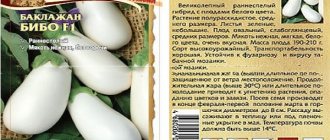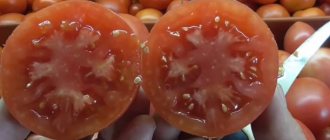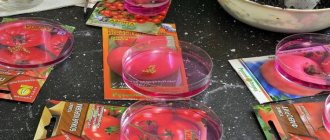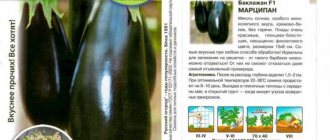Harvesting and application
Determining the degree of maturity based on the appearance of eggplants is not easy. Most often, ripeness is determined based on the length of the fruit.
Another way to find out whether a vegetable is ripe or not is by pressing on it. If the remaining dent does not level out over a long period of time, it means it is not yet ripe. If it levels out quickly, carefully cut the eggplant. To do this, use garden shears.
To keep vegetables fresh, they are covered with straw and stored in a dark, cool room. This allows you to preserve the vegetable for up to two months.
Robin Hood is pickled and salted in dozens of ways. The vegetable retains its taste and nutritional composition.
Selection and botanical description of the culture
The originator of the Robin Hood eggplant variety is the breeding and seed farming company, which developed it in Russia 8 years ago.
The bushes of this variety are low-growing, reaching a height of only 0.4 m, compact, and do not produce excessive lateral shoots. The bushes grow up to 7 fruits, the average weight of which reaches 0.3 kg.
An eggplant bush of this variety is capable of producing up to 2.5 kg of berries, which is what eggplant fruits are in the botanical sense. They are pear-shaped, their shiny skin is purple.
The eggplant fruit can grow up to 0.2 m long and up to 0.1 m in diameter, has a soft consistency pulp with high taste, a complete absence of bitterness and a small amount of seeds.
The culinary uses of this eggplant range from frying and pickling to caviar preparation and drying. In addition, Robin Hood is characterized by very early ripening, which occurs 3 months after the appearance of the first shoots and continues until the end of summer.
Growing and care
Robin Hood is an ideal variety for beginning gardeners. Unlike other eggplants, which bear fruit only if certain rules are followed, this beauty will grow and is guaranteed to produce a good harvest even in unfavorable conditions. The agricultural technology for growing the Robin Hood variety is not much different from other varieties. Eggplants are grown through seedlings. Sowing of seeds begins in March. Eggplants can be planted in a greenhouse or soil at the end of May. In mid-June, with good care, harvesting can begin. Robin Hood can bear fruit until autumn.
To grow eggplant seedlings, take seeds that are 2 years old. Before sowing, they are hardened off and tested for germination. The optimal sowing depth is no more than 2 cm. Seeds germinate within a week after sowing in warm, moist soil. During this time you need to prepare the bed.
Robin Hood seedlings are planted in long beds 60-70 cm wide. Eggplant sprouts are planted in holes at a distance of 40-50 cm from each other. The plant is compact, but for full growth and fruiting it needs access to air. You also need to form the eggplant bush in such a way that neighboring plants do not touch each other.
Planting, fertilizing
Before planting and during the growth of eggplants, you need to feed the soil with mineral fertilizers containing nitrogen and phosphorus. These elements are also contained in birch ash and legume roots. To feed eggplant, you can prepare a special solution in advance. Straw, stems and roots of nettles and legumes are placed in the container. Then compost soil mixed with ash is poured. Fill it with water, as in the photo, and close it with a lid or film.
Periodically, the film is removed and the contents are mixed. The resulting slurry needs to be watered around the plants. The first fertilizing can be done three days after planting the seedlings. During this time, it is already clear which plants have begun to grow and which ones need to be replaced.
Therefore, it is not recommended to pour fertilizer under the bush; a mixture that is not completely fermented can burn the roots and stems.
Everything about the rules for feeding eggplants is described in this video:
As eggplants grow, it is necessary to remove the lower yellowed leaves and periodically spray them to prevent diseases.
The procedure for watering the eggplant is repeated every time the top layer of soil dries out a little. First you need to clear the beds of weeds. The row spacing is deepened by throwing soil over the bed itself
This must be done carefully so that the garden tool does not damage the plants. Fertilizer is scattered between the eggplants and only then can water be released for irrigation
The furrows on both sides are covered with shutters - the water should completely saturate the beds.
Care
During the growth of eggplant, it is necessary to remove the lower yellowed leaves and periodically spray to prevent diseases.
The procedure for watering eggplants is repeated every time the top layer of soil dries out. First you need to clear the bed of weeds. The row spacing is deepened by spreading soil over the bed itself. This must be done carefully so that the garden tool does not damage the plants. Fertilizer is scattered between the eggplants and only then can water be released for irrigation. The furrows on both sides are covered with shutters - the water should completely saturate the beds.
Eggplant is a perennial herbaceous plant belonging to the nightshade family. In this article you can find out what the Bibo eggplant looks like and how to properly care for it.
Agate F1
High-yielding early hybrid. Standard bushes. Productivity – 7-8 kg per 1 sq. m. Used for preparations and in cooking.
The fruits are purple, cylindrical in shape. Weight – 220-250 g. Length – 20-23 cm. The pulp is dense, white. The fruits are not bitter and do not need to be soaked before cooking. There are almost no spikes on the cap.
Peculiarities:
- High fruit set.
- Resistance to temperature changes.
- In temperate climates, seedlings are planted in the ground in mid-May, not earlier.
- It is allowed to sow seeds in the ground - they are sown at the end of May and covered with film material, which is removed after the threat of frost has disappeared.
Transplanting
Before planting plants in a permanent place, you need to make sure that the plants have 5-6 leaves.
Hardening is carried out 7-10 days in advance Seedlings must get used to the sun and cold air and wind.
The containers are well watered and begin to be transferred to the beds.
Diseases and pests
The overall ripening of eggplants is threatened by malignant insects such as aphids and spider mites, as well as slug snails. Seedlings and young plants are often affected by:
- Blackleg can appear in vegetables due to overwatering. The soil and air become too wet and this causes fungal infection in the shoots. The root collar of the plant darkens and the roots themselves may be affected. The seedlings wither and die. Prevent this disease by maintaining regular watering schedules and monitoring soil moisture levels.
- Late blight is also a fungal disease and is spread by fungal strains living in the soil. The appearance of this infection, as in the case of blackleg, is promoted by excessive humidity. In conditions of dry air and sunny warm weather, late blight does not develop. When eggplants suffer from this fungus, the lower leaves are covered in brown spots. Depending on weather conditions, the infection spreads faster or slower to all other plant organs, including fruits.
Late blight
- Gray rot, as its name suggests, looks like a grayish coating on the leaves, stems and fruits of eggplants. It arises from the remains of contaminated plants in the soil and is activated at a temperature of 20 degrees and high humidity. Gray rot first affects the root part of the vegetable, gradually lifting the stem towards the fruit. The fruits are covered with brown spots and begin to rot. If the fungus infects the ovary, it turns black and dies.
- Mosaic on eggplants most often causes eggplants to become infected during watering. This disease manifests itself as uneven, mottled leaf color. After some time, the leaves shrink and die completely. Fruits affected by mosaic virus are irregular in shape and very small. This infection is also spread from the remains of infected plants that remain in the soil or are carried by insects, particularly aphids.
- Stolbur is characterized more for field conditions than for growing greenhouse eggplant. The leaves of infected vegetables acquire an unusual shade for them and wrinkle, as if they are corrugated. There are cracks on the stems, the internal tissues of the plant harden, and the emerging flowers do not set ovaries and collapse. If the fruit grows on bushes, it is malformed and not suitable for consumption. The source of the disease is phytoplasma organisms, which are carried by lichen insects. The peak probability of plant infection with stolbur is summer and early autumn, the hot period.
Stolbur
The main preventive measure against infections is to treat the seeds before planting:
- Planting material is disinfected with a saturated solution of potassium permanganate.
- The soil for seedlings should also be disinfected; for this, it is treated with copper-containing preparations, for example, copper sulfate.
- You can't grow eggplants in an area where potatoes or tomatoes used to grow, because pathogenic bacteria may remain in the soil, threatening to ruin your future harvest.
- If the virus still reaches your vegetables, you can treat them with Phytosporin or Zircon. These drugs are effective in combating late blight and mosaic.
- You can fight insects that harm vegetables with the help of insecticides. It is advisable to choose substances that decompose quickly and cause minimal damage to plants and soil.
- The beetles that appear in the beds can simply be collected. But if there are too many of them, after loosening the soil, scatter the following mixture between the rows: lime + ash + tobacco dust (1:2:1).
Eggplant varieties for open ground
Coming from the sunny south, eggplants not only pleased our compatriots, but also took pride of place on our tables. In fact, what other vegetable can be used to prepare so many delicious, unusual and very nutritious dishes? Despite their southern origin, eggplants can be grown in our latitudes, and not only in greenhouses, but even in open ground. Today we will talk about which varieties of eggplant are best planted in open ground.
Eggplant varieties for open ground
When choosing eggplants for growing in open ground, we advise you to pay attention to the earliest and most productive eggplant varieties. They will not only have time to ripen in the middle zone, but will even please gardeners with a fairly good harvest.
Eggplant variety "Alekseevsky"
This eggplant variety is an early ripening variety. It feels good both in a greenhouse and in open ground. Its fruits have a classic cylindrical shape and a deep dark purple color, reaching about 150 grams each at maturity. The taste of “Alekseevsky” eggplants is beyond praise - the delicate snow-white flesh is absolutely not bitter.
Eggplant variety "Robin Hood"
Eggplants with such a romantic name are distinguished by an absolutely prosaic character and produce an excellent harvest in conditions under which other varieties simply do not survive. The fruits of this variety are quite large - up to 300 grams, lilac in color and pear-shaped. In addition, this variety is ideal for lovers of homemade preparations, because its fruits are very good when salted and pickled.
Eggplant variety "Almaz"
It’s not for nothing that these eggplants received such a great name, because they can become the biggest jewel in the vegetable garden. Miniature, almost dwarf bushes of the Almaz variety are distinguished by excellent productivity, allowing you to collect about 10 kg of crop from one square meter of bed even with normal care. The Almaz fruits are cylindrical in shape, weigh 160 grams, and their skin is colored a rich dark purple color.
Eggplant variety "Dwarf early"
You can enjoy the first eggplants of the “Dwarf Early” variety 85 days after the first shoots appear. The fruits of this variety are rounded pear-shaped, dark purple in color and weigh approximately 150 grams. The variety belongs to the table variety, its fruits have a pleasant delicate taste.
Eggplant variety “Globular”
This eggplant variety belongs to the varieties of medium ripeness. The first fruits on it ripen on the hundredth day after planting in the ground and have a round shape. The average weight of one eggplant is about 200 grams, but some giants grow up to 700 grams. Although this variety does not have a super pleasant taste, it is perfectly stored and can withstand transportation.
Eggplant variety "Simferopol"
Refers to varieties of medium ripeness. Its fruits are oval in shape and weigh from 200 to 250 grams. The first fruits ripen 110 days after emergence. They have a pleasant taste and are suitable for stuffing or preparing eggplant caviar.
Eggplant variety "Maksik"
Like other new eggplant varieties, the “Maksik” variety is distinguished by its compact bushes coupled with increased productivity. From one square meter of bed you can collect more than 10 kg of fruits, each of which has the shape of an elongated cylinder of dark purple color. The weight of one fruit is about 200 grams.
Eggplant variety “Snowy”
For lovers of white eggplant varieties, we can recommend the “Snowy” eggplant variety for open ground. It belongs to the early ripening varieties, and its fruits reach up to 300 grams and have a cylindrical shape.
womanadvice.ru
Collection and storage
It is difficult to determine the degree of ripeness by the appearance of a vegetable, so they are guided by the length of the fruit.
Another way to tell whether an eggplant is ripe or not. You should press on the fruit; if the dent does not straighten out for a long time, it means that it is not yet ripe. If it levels out quickly, you should carefully cut the eggplant using garden shears.
Eggplants are stored fresh by covering them with straw and storing them in a dark, cool room. In this way, the vegetable is stored for 1-2 months.
Robin Hood is suitable for any method of pickling or salting. Perfectly preserves taste and nutritional composition.
Landing dates
It is impossible to give a specific date for sowing eggplant seeds. The timing depends not only on the variety chosen by the summer resident, but also on the climate of the growing region. Another criterion taken into account is the method of cultivation, in open or closed ground, by direct sowing in the ground or by seedlings.
When grown in a greenhouse by seedlings, the seeds are sown in the last ten days of February. Provided that the finished seedlings will be planted in the greenhouse in early May.
If the crop is grown in open ground, in seedlings, then the seeds are sown in mid-March, and planted in a permanent place in early June.
If the greenhouse is well heated, then sowing begins at the end of January in order to get an earlier harvest. It is impossible to name a specific date; it all depends on the choice of the summer resident.
How to grow this variety yourself
The Robin Hood eggplant variety is suitable for beginning gardeners, as it will bear fruit even in an environment unfavorable for growth. Seeds for seedlings are sown in mid-March.
Growing seedlings
To cultivate seedlings, two-year-old seeds are used. Before sowing, they check for germination, disinfect, and strengthen. For these purposes, a manganese solution and growth stimulants “Epin” and “Kornevin” are used.
It is worth sowing no deeper than 2 cm in warm, moist soil. The first shoots appear within seven days after sowing. At this time, the beds are prepared.
Transfer
The bushes are transplanted into elongated beds at least 60 cm wide. It is recommended to leave a space of 40-50 cm between the seedlings. The plant is small, but for good development and fruiting it needs constant free access to air.
The bush is formed so that plants growing nearby do not interfere with each other. Before planting, the soil is fertilized with fortified fertilizers containing nitrogen and phosphorus.
Further care
To fertilize the soil, use birch ash, legume roots or a special solution. To prepare it, add straw, branches and roots of nettles and legumes. Then compost soil mixed with ash is poured. Fill with water and cover with a lid or film.
The lid is removed from time to time and the solution is stirred. The resulting mixture is used to treat the soil around the plants. Feeding begins three days after planting the seedlings. It is not possible to water the bush itself with fertilizer - you can burn the stems and roots.
Features of cultivation and possible difficulties
As they grow, systematically cleaning the lower yellowed leaves and spraying them is carried out to prevent diseases and protect against pests.
Water the vegetables every time the top layer of soil dries out. Before watering, the beds are cleared of weeds. By adding soil to the bed itself, the row spacing is made deeper. Carry out this work carefully so as not to damage the roots or the plants themselves. Fertilizers are placed between the bushes and then watered. The beds must be completely watered.
To increase productivity, it is recommended to form bushes. When they reach 25 cm, pinching is done, which has a beneficial effect on the development of lateral shoots. From the shoots, 6-7 of the strongest are selected, the rest are removed. To save energy, plants promptly remove yellow leaves, deformed fruits and shoots without fruits.
Diseases and pests characteristic of the variety
Eggplants most often suffer from the Colorado potato beetle, to combat which chemicals and folk recipes are used. Ideally, it is recommended to use chemical-free control methods. Their disadvantage is that they have a short-term effect and require frequent repetition of treatment. But substances harmful to the human body do not accumulate in the fruits.
Chemicals are more effective, but harmful compounds accumulate in the plant, which then end up in the fruit.
To cultivate small areas of land, use the following composition:
- slaked lime;
- wood ash;
- tobacco dust.
The ingredients are mixed in a ratio of 1:2:1 and scattered in the beds between the rows of seedlings.
Eggplants are prone to the following diseases:
For treatment and prevention, timely treatment with disinfectants and strengthening agents, for example Fitosporin, is carried out.
How to grow seedlings at home
Since this variety is distinguished by its ability to produce a consistently high yield even in the absence of optimal conditions for its growth, growing its seedlings is also not particularly difficult. But you need to know some features.
Deadlines
Determining when it is time to sow seeds in the soil for growing seedlings is quite simple, based on the local climate conditions. In places with a temperate climate, seedlings are transplanted into open ground from mid to late May.
Around the same time, seedlings are also planted in regions with colder climates, but in this situation, planting is carried out in greenhouses. And since at least 40 days pass from the time of sowing the seeds until the seedlings are ready for planting in the soil, the seeds are usually sown no later than March 15.
The soil
Although this eggplant variety can grow safely on any soil, slightly acidic or neutral soil is preferable to obtain high-quality seedlings. To disinfect it, it must be heated in the oven for 60 minutes at 90°C.
We recommend reading what to do if eggplants in the greenhouse do not set.
The best option for growing seedlings is a professionally prepared substrate, sold in specialized stores. However, you can prepare quite high-quality soil with your own hands. There are several ways to make effective fertilizer mixtures.
To prepare them you should mix:
- 2 parts humus with 1 part turf soil;
- 3 parts peat with 1 part rotting sawdust;
- 2 parts humus with 1 part peat.
Capacities
Containers in which you can grow eggplant seedlings can be in the form of:
- wooden or plastic boxes with low sides;
- plastic, cardboard or paper cups;
- plastic seedling cassettes;
- peat pots;
- peat washers.
There is no fundamental difference in choosing a container for obtaining seedlings. However, one should take into account the fact that the root system of eggplants reacts extremely negatively to transplantation, so the best option when obtaining seedlings is the ability to do without picking when planting seedlings in a stationary place of growth.
In this sense, cardboard and paper glasses or pots and peat tablets are preferable. They allow you to transfer seedlings into the soil without removing them from the containers. It is especially effective to grow seedlings in peat tablets, which, in addition to peat itself, which is a good fertilizer, also contain many other nutrients.
Did you know? If you rub strips of eggplant fruit on your teeth, this will effectively rid them of plaque.
Seed preparation
Although eggplant seeds remain viable for up to 4 years, usually 2-year-old planting material is selected for sowing. Before planting, it is disinfected for half an hour with a 1% manganese solution, then washed in water and dried.
It is also recommended to treat the seeds with one of the growth stimulants, which activate the successful germination of planting material.
Sowing seeds
The seeds are sown into the substrate no deeper than 2 cm. However, the soil should not be compacted after sowing, since weak eggplant sprouts may not have enough strength to break through the compacted soil layer.
Seeds are sown in the center of the container in an amount of 2-3 pieces at a distance of up to 1 cm from each other. After the sprouts appear, the strongest of them is left, and the rest are carefully cut off.
Seedling care
After sowing the seeds in containers to create a greenhouse effect, the latter must be placed under glass or transparent film and placed in a dark place with an ambient temperature of at least +23°C.
When seedlings appear, the seedling containers should be freed from the covering and moved to a sufficiently lit place with a temperature from +14°C to +16°C in the complete absence of drafts.
Important! Under no circumstances should the ambient temperature be lowered below +14
°
C, since this can lead to inhibition of seedling growth and even to its death.
Good illumination, which should last at least 12 hours, will not allow the sprouts to stretch out too much, and the low temperature stimulates the development of a strong root system and will serve as a good means of hardening off the seedlings. In early spring, good illumination can only be achieved with the help of artificial lighting.
Balanced watering of seedlings is very important during this period. In the first 10 days, watering with warm water in the morning is enough, then watering should be more active. It is best to do this using a tray, but you must ensure that water does not accumulate there. In addition, when watering, you should not wet the surface of the leaves with water, as this can lead to the occurrence of fungal diseases.
At first, the sprouts have enough nutrients that are present in a properly prepared substrate or in peat tablets. However, as the seedlings develop, they require nutrients in increasing quantities, so they must be fed before transplanting to a permanent place of growth.
It is best to combine fertilizing with complex fertilizers with watering, for which 25 g of fertilizers must be dissolved in a bucket of water. If there are no factory-made complex fertilizers, you can do it yourself.
When the first leaf appears on the seedlings, it can be fed with an infusion of bird droppings or mullein: for this, the infusion of bird droppings is diluted with water in a ratio of 1:20, and the infusion of mullein - 1:5. After 10 days, fertilize with minerals, for which 8 g of potassium salt, 10 g of ammonium sulfate and 25 g of superphosphate are diluted in 5 liters of water. This solution must be poured as carefully as possible under the bush, in no case getting it on the leaves.
Hardening of seedlings
Hardening of seedlings begins from the moment when the glass or transparent film coating is removed from the containers with seedlings and they are placed in a cool place. About 2 weeks before planting the seedlings in a permanent place, the main hardening is carried out.
Important! During the hardening procedure, the decrease in temperature should not be accompanied by a decrease in illumination.
In its process, the intensity of watering is gradually reduced, as well as the ambient temperature, for which containers with seedlings are taken out for a couple of hours, first into the corridor, then into a glazed loggia, then onto a balcony or into the open air in the yard, gradually increasing the period of stay of the seedlings in low-temperature conditions. temperature.
Transplanting seedlings into the ground and further care
To obtain a good result, it is important to determine in advance the date and place of planting and create optimal conditions for seedlings. Before transplanting eggplants, you need to fertilize the soil with mineral fertilizers containing phosphorus and nitrogen.
You can prepare compost from straw, nettle stems, legumes, and ash by filling all the components with water and covering the mixture with film. It is necessary to stir the contents periodically. Already three days after planting, you can water the soil around the seedlings with prepared compost
It is important to remember that you should not pour the slurry directly under the root
Preparation for transplantation and hardening
Preliminary hardening of eggplant seedlings begins 10 days after sowing the seeds. At this point, the film or glass covering is removed, and the plants themselves are placed in a well-lit place with a lower air temperature.
As hardening progresses, it is necessary to limit watering by reducing its intensity. To prepare seedlings for transplanting, you must first take them out into the corridor, then into the loggia, and only then into the open air. In this case, the duration of the plant’s stay in low temperature conditions should be gradually increased. Ready hardened seedlings should be about 15 cm and have 6-9 leaves. In this case, at least 65 days must pass from the date of sowing the seeds.
Transplantation into the ground
The specific time for planting seedlings directly depends on climatic conditions
To do this, it is important that the average daily temperature does not fall below 14 degrees Celsius. The most suitable soil would be loose fertile soil with sand, enriched with peat and humus
Before planting, you need to make holes in the soil that are larger than the height of the cups with seedlings and pour water into them. Then remove the plants from the cups along with the earthen ball, being careful not to damage the root system, and plant them in the ground. The distance between bushes should be approximately 30 cm, and between rows - 40 cm.
Watering
It is necessary to moisten the soil regularly as its top layer dries. It is recommended to make grooves between the rows into which water is poured. In this case, it is advisable to make dampers on both sides so that the soil can be saturated with moisture as much as possible.
Watering times depend on weather conditions:
- Before the flowering period, it is recommended to water the eggplants generously twice a week;
- when the fruits ripen, the weekly frequency of soil moisture should be increased to three;
- in rainy weather, on the contrary, it is enough to water the eggplants twice in 14 days.
Fertilizers
During the season, plants are fertilized three times. At the same time, it is undesirable to apply nitrogen fertilizers before the appearance of the first fruits, since they inhibit the formation of ovaries, positively affecting the green mass. It is recommended to water the eggplants once every 2 weeks with a solution of rotted bird droppings, cow manure, and apply mineral fertilizers containing iron, manganese, boron (5 g per 1 sq. m).
Diseases and pests
The greatest threat to the Robin Hood variety is:
The easiest way to identify Colorado potato beetles. They can be pickled or collected by hand.
Spider mites most often bother eggplants when grown in a greenhouse. To combat this pest, various chemical and biological preparations are used. Among them are:
The same means are suitable for combating aphids, which infect plant bushes everywhere. There are also folk methods of fighting using a solution of potassium permanganate and green soap.
The most common diseases affecting this crop are late blight and tobacco mosaic:
- To prevent late blight, copper sulfate is used to treat the soil before planting seedlings and after they take root.
- When the first signs of tobacco mosaic appear, it is recommended to treat the eggplant leaves with a 10% aqueous solution of whey with the addition of microfertilizers. In addition, it is recommended to replace the top layer of soil to a depth of 20 cm.
Characteristics of the variety
Variety characteristics are an important aspect when choosing a plant. It is worth considering what qualities are inherent in the Robin Hood eggplant.
Productivity and fruiting
This not too large bush of the Robin Hood variety makes it possible to reap a good harvest. It grows up to 7 fruits, each weighing 300 g. The total harvest is about 2.5 kg. Planted as seedlings on March 10-15, eggplants will delight you with ripe fruits at the end of June. The interval from germination to fruit ripening is no more than 100 days. It can bear fruit until the end of August with good care, timely watering and fertilization.
Area of application of fruits
There is probably no person who does not enjoy an eggplant dish. The range of its use is wide. Fried, baked eggplants, various winter preparations, lecho and sauces. The caviar made from them is very tasty. Eggplants contain a bitter substance called corned beef. To get an edible dish, you should salt the chopped vegetables and leave for a while, then rinse with water.
Resistance to diseases and pests
The most dangerous pests of eggplants:
- spider mite;
- aphid;
- Colorado beetle.
Spider mites are a common pest of indoor soil. It appears in the dry, windless climate of a greenhouse. It can be eliminated by spraying with chemical or biological agents. The best biological agents are:
- "Fitoverm";
- "Agrovertin";
- "Iskra-bio";
- "Healthy Garden"
Important!
They are not dangerous to humans and beneficial insects. Aphids - damage vegetable crops in the greenhouse and in open beds. Tender aphids can be washed off leaves and shoots with water; it is good to use solutions of green soap and potassium permanganate. The best would be biological drugs, such as those for spider mites.
Colorado beetle. This potato pest requires chemicals to kill. Eggplant plantings are not as large as a potato field, so it is better to simply collect this pest from the bushes and destroy it. If you do this constantly, then it will not have time to leave its larvae, which eat the greens.
The Robin Hood variety, like all eggplants, is most often susceptible to diseases such as late blight and tobacco mosaic. To combat late blight, copper-containing solutions are used - copper sulfate, Bordeaux mixture. The soil is treated with such compounds before planting seedlings to prevent the formation of disease. The treatment is repeated after the seedlings have rooted.
Important! Biological preparations “Fitosporin”, “Zircon” or others are used to treat plants in the greenhouse.
This treatment will prevent the fruit from being saturated with chemical elements, which is especially dangerous in closed spaces.
Planting and growing
Robin Hood is quite easy to grow, so it is perfect for beginner gardeners. Seeds are planted from late February to mid-March. Pour soil treated with a weak solution of potassium permanganate into a box or large plastic container and make holes in it no more than 1 centimeter deep. A grain is placed in each hole, lightly sprinkled with earth, but not crushed. The soil is moistened, the top of the box is covered with glass or film and put in a sunny place.
7-10 days after planting, the seeds sprout. Over time, they will get stronger, and after a month they carry out the first picking - the plants are separated and replanted in separate containers. After picking, the growth of seedlings may slow down somewhat, there is nothing to worry about, the plants adapt to new conditions. Picking protects bushes from excessive stretching.
With warming, they begin to transplant the grown seedlings into greenhouse soil. The optimal time for transplantation is mid-May. It is advisable to plant the plants no later than the beginning of June, otherwise fruiting will shift to a later date. 3-4 bushes are placed per square meter, the ground is watered after transplantation and time (usually 1-2 weeks) is given for the seedlings to take root.
Robin Hood can be fed only 2 weeks after growing. Nitrogen-containing fertilizers are perfect for the first feeding - they help in growing green mass and make the trunk strong. Here is an example of fast-acting feeding:
- tbsp nitrophoska;
- 10 liters of water.
Dilute the powder in warm water and water the eggplant bushes in the morning at the root for 2-3 weeks at intervals of once every 5-7 days.
Reviews from summer residents and gardeners
Versatility, unpretentiousness, excellent taste determined the popularity of the Robin Hood variety. Many admirers of this vegetable share positive emotions by leaving reviews on the Internet:
Svetlana, 62 years old: “I saw Robin Hood eggplants at the market for the first time. I wanted to grow the same fruits myself. To do this, I purchased ready-made seedlings, which I planted in warm soil on May 12, covering them with two layers of film. Due to heavy rainfall, I watered the plants once every two weeks. There were some disappointments. The first flowers have fallen. Later it became warmer and I began to remove the shelter for the day. Further growth and development proceeded well, and the tasty fruits ripened in early July.”
Maria, 40 years old: “I am growing eggplants in a greenhouse. Over the course of five years, I became acquainted with many varieties of vegetables. Robin Hood consistently pleases with its unpretentiousness and abundant fruiting. Every year I plant 20 plant bushes in a six-meter bed. At the same time, I grow seedlings myself, choosing the best seeds for this. Each seedling consistently produces about 2 kg of fruit per season. I recommend this variety to everyone."
Tatyana, 43 years old: “In my family, eggplant caviar is one of the most favorite delicacies in winter. To prepare it, I always bought vegetables at the market. But one day a neighbor offered several bushes of seedlings to try. I planted it in open ground in the second half of May, and a month later the first fruits, tender in taste, were harvested. Next year, I specially prepared a bed with fertile soil, as well as a greenhouse for growing seedlings.”
The Robin Hood eggplant variety is ideal for all types of culinary processing. In addition to its high nutritional value, the vegetable is characterized by pronounced medicinal properties. It is quite simple to grow, since the variety is unpretentious and easily adapts to different conditions, delighting with a consistently high yield.
Characteristics and description of the variety
Robin Hood is considered an early ripening variety; the bush begins to bear fruit 90-100 days after planting. The fruits have a beautiful shape, reminiscent of a pear. The length of the eggplant is up to 20 centimeters, with a diameter of 8 centimeters. The weight of the fetus ranges from 200 to 300 grams. The skin color is dark purple, almost black; even without sun, eggplants shimmer beautifully with a glossy sheen.
There is no bitterness in the taste of the vegetable, which makes it almost a favorite product in the kitchen. Ripe eggplants can be added anywhere: to stews, meat dishes. The fruits are suitable for frying and stewing; they can be used in preparations and to make caviar.
The bush grows to a height of 80-100 meters; tying it to a trellis or other support is mandatory and should be done almost immediately after transplanting the seedlings into the greenhouse. The plant produces few stepsons, which is very convenient for gardeners. Side shoots are pinched as soon as they appear. The plant is formed into 1-2 stems. There are practically no thorns on the stem.
The yield of Robin Hood, subject to the correct agricultural cultivation technology, is 8-12 kg per planting meter of land. However, the indicator may decrease due to low temperature, excessive humidity and insufficient lighting.
Robin Hood is suitable for all regions without exception, but only for greenhouse breeding. Not suitable for planting outside, with the exception of the southern regions of the country. Frosts and cold snaps at night can be destructive for plants, so maintaining the temperature at plus 22-25 degrees is simply necessary for normal fruiting.
The advantages of the variety include:
- lack of bitterness in taste;
- large size;
- beautiful skin color;
- high keeping quality;
- greater productivity.
Disadvantages include poor resistance to frost and long ripening of fruits in the absence of light.
Robin Hood's immune capacity is at a high level. The plant is weakly affected by mosaic viruses and late blight, but sometimes gray rot can form. The risk of rot infection increases especially if the humidity in the greenhouse is high and there is no sun. To avoid unpleasant consequences, plants and soil are treated with any fungicidal agents 2 times per season.
Read also: Features of the drug Abiga-Peak: composition, indications and instructions for use
Advantages and disadvantages of the variety
The main advantages of Robin Hood eggplant:
- early ripening;
- compact;
- has few thorns;
- does not require the formation of a bush;
- productive.
Flaws:
- the need to garter the bush for stability;
- When planting early in open ground, it requires shelter.
According to reviews, Robin Hood eggplant is a fairly popular variety among gardeners; the photo allows you to see the healthy seedlings of this plant.
Description of the Robin Hood eggplant variety, its characteristics and yield
Robin Hood is capable of not deteriorating for a long time in cool conditions (at a temperature of 10-16 degrees Celsius). The harvested crop can be placed in the refrigerator or cellar; the eggplants will remain there for at least a month. Before removing, wipe the skin with a dry cloth and wrap each fruit in newspaper - this will prevent moisture from entering.
The culture is not widespread among summer residents. Her fans and admirers choose varieties that suit them in all respects. One of the representatives of this vegetable, Robin Hood, is an eggplant that breaks records for taste among its own kind.
In order to correctly place the plant on the site and avoid mistakes when growing it, it is necessary to study the characteristic properties of the variety.
- height: 70-90 cm;
- there are few side shoots;
- there are a lot of ovaries;
- ripens in 90 days.
- shape: pear-shaped;
- color: purple;
- weight: 300 g;
- length 20 cm;
- diameter: 9 cm;
- pulp: without seeds, tender and without bitterness;
- the skin is thin.
Thanks to these characteristics, the Robin Hood eggplant variety is gaining recognition among summer residents and gaining popularity.
The Robin Hood type of eggplant has many positive properties. The variety has practically no downsides. Bushes with a small number of branches bear a lot of fruit, so it is necessary to tie the bushes to supports. This is the only drawback of this type of eggplant. Preventative treatment against diseases and pests is also required.
It is impossible to give a specific date for sowing eggplant seeds. The timing depends not only on the variety chosen by the summer resident, but also on the climate of the growing region. Another criterion taken into account is the method of cultivation, in open or closed ground, by direct sowing in the ground or by seedlings.
When grown in a greenhouse by seedlings, the seeds are sown in the last ten days of February. Provided that the finished seedlings will be planted in the greenhouse in early May.
If the greenhouse is well heated, then sowing begins at the end of January in order to get an earlier harvest. It is impossible to name a specific date; it all depends on the choice of the summer resident.
When planting eggplant seeds, you need to follow simple recommendations, and the plant will be pleased with the results.
Planting material for sowing is taken 2 years old, no less. And the germination of such seeds is excellent, and the yield is high.
Prepare fertile soil, water it and make furrows. Planting material is immersed in a weak solution of potassium permanganate for 30 minutes. Afterwards, it is washed with running water and allowed to dry, then sown. The seeds are planted to a depth of 2 cm. Then they are covered with polyethylene and placed in a warm, dark place until shoots appear. This takes from 10 to 14 days.
Eggplant seedlings do not tolerate picking. Therefore, it is advisable to place it in separate pots. And transplant immediately to a permanent place.
Harvesting
The ovaries on the bushes form at the end of June, and mature fruits will appear in 3-4 weeks. At first, the color of the vegetables is green, but every day the color changes - the fruits darken. A clear sign of ripeness is the presence of a black color and large size of the vegetable. If its diameter has already reached 5-6 centimeters, then the fruit can be picked.
Robin Hood is capable of not deteriorating for a long time in cool conditions (at a temperature of 10-16 degrees Celsius). The harvested crop can be placed in the refrigerator or cellar; the eggplants will remain there for at least a month. Before removing, wipe the skin with a dry cloth and wrap each fruit in newspaper - this will prevent moisture from entering.
Growing
Marzipan eggplants are grown while observing all their characteristics.
Planting seeds
The seeds are sown at the end of March, they require preparation: they are heated for 4 hours at a temperature of 24-26˚C, then kept for about 40 minutes at 40˚C. To disinfect, they are soaked for 20 minutes in a solution of potassium permanganate.
To increase germination, the seeds are kept for 12 hours in a Zircon solution, after which they are wrapped in a wet cloth and transferredsdf.ncz to a warm place.
Description of the features of planting Marzipan F1 seeds:
Planting containers are filled 2/3 with soil and moistened. A depression is made in the central part of the container, in which the germinated seed is placed and covered with a small layer of soil. The containers are covered with film. If the seeds are planted in a large box, furrows are made on top of the soil at a distance of 5-6 cm from each other
The box is covered with glass or film and sent to a warm place with a temperature of 25-28˚C. After 7 days, shoots are expected, after which the covering must be removed and the seedlings placed in a bright place. To avoid stretching the seedlings, the temperature is reduced to 19-20˚ C. Water the seedlings in the morning with warm water, do this carefully, without eroding the soil.
Sprout care
Before planting, seedlings need to be hardened off
Seedlings are transplanted into 10*10 cm containers after the appearance of 2 leaves.
Preparing containers for transplantation: holes are created at the bottom, a thin layer of drainage made of expanded clay, pebbles, and broken bricks is filled.
The seedlings need to be watered 2 hours before transplanting. Then they carefully move to a new place, sprinkle with moistened soil up to the cotyledon leaves. After transplantation, a slowdown in growth is observed, this is due to the formation of a powerful root system. The plant is protected from sunlight.
Marzipan variety F1 is watered 5-6 days after picking. A month before planting on the plot, the seedlings begin to harden off. Containers with plants are taken out into the air, gradually increasing the time they are in the air. To do this, containers with plants are taken out into the fresh air.
Transplanting
Marzipan seedlings are planted on the site when 8-12 leaves grow.
Eggplants are a heat-loving crop; they are transplanted into a greenhouse after May 14-15, and into open ground at the beginning of June.
When the bush reaches 30 cm, the first garter is made; after the side shoots appear, they are tied to a support. 2-3 strong shoots are left on the bush, the rest are removed. On the main stem of the eggplant variety Marzipan F1, all the leaves that grow below the fork are torn off. Above the fork, shoots without fruits are removed. To get rid of strong density on the bushes near the tops of the stems, a couple of leaves are removed.
To ensure good lighting and reduce the risk of damage from gray rot, the foliage is cut off. Secondary shoots must be removed.
It is important to remove dry and damaged leaves, at the end of the season, pinch the tops of the stems and leave up to 7 ovaries, they will have time to ripen before frost. During this period, flowers are also picked off.
Fertilizer
Fertilizer application procedure:
- after the first leaves appear, a mixture of fertilizers is added - 5 g of ammonium nitrate, 30 g of superphosphate, 10 g of potassium sulfate are added to 10 liters of water;
- 10 days before planting the seedlings on the site, a solution is added to the soil based on a dilution of 60-70 g of superphosphate and 20-25 g of potassium salt in 10 liters of water.
Eggplants need to be fertilized both during flowering and fruiting:
- when flowering, a fertilizer mixture is prepared: 5 g of urea, potassium sulfate, 20 g of superphosphate are dissolved in 10 liters of water;
- During the fruiting period, a solution is used: 10 g of superphosphate, 10 g of potassium salt in 10 liters of water.
Plant care
Eggplant responds well to fertilizing with nitrogen and potassium and requires less phosphorus. However, nitrogen delays the formation of ovaries in the crop; before the formation of the first fruits, nitrogen fertilizing should be limited. For further care, this vegetable is watered weekly with a solution of bird droppings or manure.
Advice! A good fertilizer would be obtained from 1 tbsp. spoons of azofoska and 2 teaspoons of the Uniflor-micro mixture, dissolved in 10 liters of water.
Water eggplants depending on the condition of the soil and ambient temperature. Watering too frequently is harmful for them; it is better to do it more abundantly, but less often. Hilling up, removing weeds, removing excess shoots - these are the basic requirements of agricultural technology for growing crops.
Eggplant is a heat-loving plant. At high humidity and low temperatures (less than 150C), the plant does not set fruit well. To improve their formation, the bushes are sprayed with the preparations “Bud” and “Ovary”. Ripe fruits must be removed in a timely manner to allow new ones to grow.
Planting seeds
When planting eggplant seeds, you need to follow simple recommendations, and the plant will be pleased with the results.
Planting material for sowing is taken 2 years old, no less. And the germination of such seeds is excellent, and the yield is high.
Prepare fertile soil, water it and make furrows. Planting material is immersed in a weak solution of potassium permanganate for 30 minutes. Afterwards, it is washed with running water and allowed to dry, then sown. The seeds are planted to a depth of 2 cm. Then they are covered with polyethylene and placed in a warm, dark place until shoots appear. This takes from 10 to 14 days.
The optimal temperature for germination is +22…+25 ⁰С, after germination, reduce it to +13…+15 ⁰С. In 3-5 days, the root system will form, and the temperature is again raised to +25 ⁰C.
Eggplant seedlings do not tolerate picking. Therefore, it is advisable to place it in separate pots. And transplant immediately to a permanent place.
Soil preparation
In order for plants to develop and grow well, you need to make fertile soil for them. A suitable site is chosen, on the sunny side and sheltered from the wind.
There is no need to rush to plant in open ground; the crop is susceptible to night frosts. If there is a drop in temperature, it is better to play it safe and cover the sprouts with covering material.
The soil for the beds must be fertile and loose. If there is a lack of nutritional components, humus is added at the rate of 3-4 kg per 1 m2. If necessary, add complex mineral supplements.
To ensure the looseness of the bed, river sand, peat or humus are added to it. The soil is mixed and holes are prepared for planting.
Sprout care
After the seedlings begin to rise, they must be watered, avoiding drying out and waterlogging. Water moderately, several times a week.
Feed with complex fertilizers to support plants. The most necessary elements are:
When yellow leaves appear, remove them.
Reviews from those who grew
To make a choice of variety, beginners usually study reviews from experienced farmers. Below are some of them.
Lyubov, 45 years old, Moscow, Stupinsky district : “I decided to plant eggplants for the first time in 2018. I sowed the first packet - there were no shoots. Then I sowed another variety and it sprouted very well. I was satisfied with the harvest. I used only my own eggplants for cooking and canning. The variety that has not sprouted is hippopotamus. The ascendant is Robin Hood. Eggplant, like peppers, does not like transplanting. It is worth replanting only with a lump of earth so as not to touch the roots. I planted one seed per cell, after the first true leaf appeared, I transplanted it into larger containers along with the soil. Grown in a greenhouse. I didn't pay much time or attention to them. Agricultural technology like pepper. Only with eggplant I removed the shoots and lower leaves, but I don’t do this with peppers.”
Anton, 50 years old, Bryansk region : “When a plot of my own land appeared, the desire to have my own vegetable garden, and always with a greenhouse, appeared. I started by growing greens under film. During this time, I “ennobled” my poor clay soil. I built a greenhouse in one of the sunniest places and decided to try planting eggplants. The choice fell on the Robin Hood variety because it seemed to me the most unpretentious.
A photo of a ripe vegetable on a package helped me finally make my choice. Shoots appeared quickly. I bought fertilizer in tablet form at the store, diluted it with water and watered it every three days. After a month and a half, there were beautiful seedlings in the pots, each with 5-6 leaves. I planted it in my greenhouse and covered the row spacing with ammonium nitrate. The bushes sprouted quickly, and within a month I was already tasting the first fruits. I often cook vegetable stew with eggplants. The taste of Robin Hood is beyond praise - the flesh is not bitter at all, there are almost no seeds. Next year I’ll plant eggplants in the garden - the soil should be ready by this time.”










